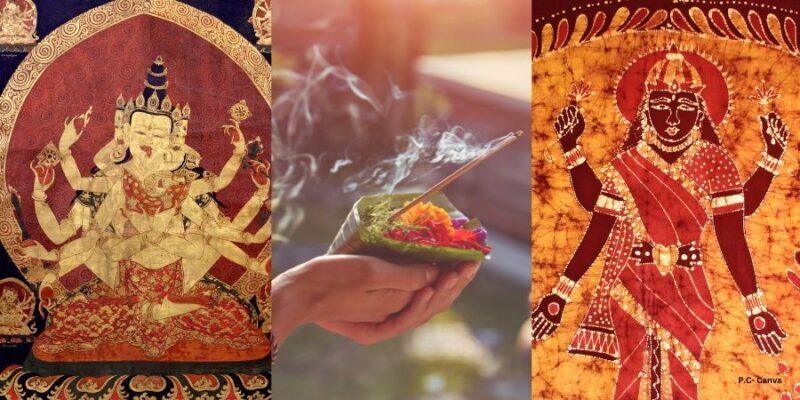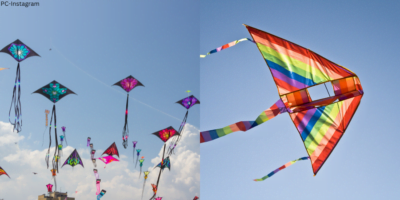Did you hear that? The Krishna Temple in Kerala’s Thrissur District now has a mechanical elephant to help us pray to the gods, making it one of a kind among Indian temples.
Indian temples are unique in so many ways that one can’t even imagine, some have a unique look, while others serve the gods in a unique way.
Here are our top 5 favourite Indian temples, each of which will astound you with its unique character. These temples showcase unique phenomena of science, culture and of belief.
Munch Murugan, A God Who Developed A Taste For Chocolates

A remote area of Kerala demonstrates how contemporary the gods can be. Most Hindu deities are known to have a favourite dish; for example, Ayyappa enjoys ghee, Krishna enjoys butter, and Ganesh enjoys laddus.
However, thanks to a young boy, Balamurugan of Alappuzha developed a taste for chocolates, specifically Munch. In fact, now the god is known as “Munch Murugan” in popular culture.
The infant Murugan resides in the Chemmoth Sree Subramaniya Swami Temple and is Shiva’s son. It is said that a young boy once offered chocolate to Balamurugan, and from there a unique offering became the culture of the place.
Anoop A. Chemmoth, the caretaker of the temple, claims that the custom of offering chocolate to the god started about six years ago when a young boy who lived nearby the temple steadfastly refused to offer anything other than a Munch.
After his innocent offering, his wishes came true, and the word spread around the village. Soon after, many kids started showing up with munch to offer to the god and now this innocent story has become the identity of the place.
Chinese Kali Temple Loves Noddles
Everything is a component of our faith, a piece of faith infused with our religious convictions, sometimes letting us pursue a different course of action. One of the best examples of this harmonious fusion is Kolkata Chinatown. The only Chinatown in India, Tangra, is home to the Chinese Kali Mandir.
Chinese residents of Tangra, make up the majority of the temple’s followers. However, in addition to the Chinese worshippers, Bengalis from that region also go to the temple to offer their prayers.
The Chinese Kali temple in Tangra, Kolkata, was constructed by members of the Bengali and Chinese communities about 20 years ago. A mythological story claims that a 10-year-old Chinese boy fell ill. Nobody was able to cure him, and nothing was helping to make his health any better.
As a last resort, his parents gave it all in the hands of a stone they called their protector and god. miraculously, the boy recovered and faith in the stone became a sign of hope.
The Chinese community members, the majority of whom are Buddhists and some of whom are Christians, joined their Bengali brethren in building the temple as the boy recovered.

The rituals practised here are now a mash-up of Chinese and Hindu customs. The Christian and Buddhist Chinese light tall candles and Chinese incense sticks while the hymns are sung and the ceremony is conducted according to Hindu beliefs.
In this temple, Goddess Kali is served Chinese food like noodles, chop suey, sticky rice, and various other dishes.
Kamakhya Devi Temple, Goddess Embraces The Best of Womanhood
It is one of the oldest temples in Assam and is thought to have been built in the eighth century. The temple is devoted to the mother goddess Kamakhya. The Ahom kings constructed The temple of the goddess Kamakhya.

This Indian temple is thought to be the location where the goddess’ womb fell, making it one of the holiest shaktipeethas (religious shrines where Goddess Sati’s severed body parts fell).
According to legend, Goddess Sati set herself on fire when her husband, Lord Shiva, was treated disrespectfully in her paternal home. Lord Shiva, who was devastated, carried her body on His shoulders as He wreaked havoc throughout the cosmos.
When Lord Vishnu used his divine sword, the Sudarshana chakra, to slice through Sati’s body to calm the enraged God, pieces of the body scattered across India and gave rise to shaktipeetha.
According to legend, Devi Sati’s mythical womb is housed in this temple. Therefore, it is also a symbol of supreme female power and fertility. Every year, thousands of worshippers come to the temple, particularly during the Ambubachi Mela in June.
The temple is closed for three days during the annual fair festival of Ambubachi, and on the fourth day, a moist red cloth containing the menstrual fluid of the goddess Kamakhya is distributed to devotees. In the Hindu religion, this item of clothing is regarded as extremely lucky.
Whereas a lot of people still find it offensive to discuss the menstrual cycle and are reluctant to do so in public, this temple honours the cycle in the most mystic manner.
Golu Mata Fulfil All Your Wishes If You Write A Letter To Her
We all have something to ask from the gods, but have you ever written a letter to the gods, mentioning what you need? Writing a letter to the almighty is something an innocent desperate kid would do, right.
However, a lot of adults have been doing it for years in the Nainital Hills of Uttrakhand. The local hill tribes‘ place of worship is the well-known Lord Golu temple, which is located in the tiny town of Ghorakhal and is 2000 metres high from sea level.
If you ever have the chance to enter the temple, you’ll be shocked to see how extravagantly decorated it is with “Gantiyan,” the bras bells used in Indian temples for worship. The temple campus is covered in hundreds of hanging bells.

The temple’s bells are not the only distinctive feature of this Indian temple; you can also find hundreds of scrolls tied to trees around the temple’s grounds that bear the wishes of its followers.
This temple is a wonder in itself; it is exquisitely decorated, and the offerings made to the gods include handwritten notes made by Golu mata devotees, along with bells to clearly signal the need for blessing.
Bhanwal Mata – Enjoys a drink With The Devotee
The Rajasthani village of Bhanwalgarh, which is part of the Merta tehsil of the Nagaur district, is home to the Bhanwal Mata temple. Two incarnations of Mata Kali and Brahmini are revered here. And both of their particular favourites are served here by the devotes.
Originally known as Gori and Kali Bhanwal, they were goddesses of the local lutera’s, or thieves, who use to hide in the jungles of the area.
While Gori Bhanwal, like many other goddesses, accepts greetings made of sugar in the offering, Kali Bhanwal enjoys alcohol.

There are many temples in India where alcohol is offered to the gods but the fact that the drink offered to the Kali Bhanwal is actually consumed, sets this temple apart from others in India that accept alcohol as an offering.
You read that right—the drinks offered to the gods go missing as soon as it is presented.
Despite years of research and investigation, the only plausible explanation is that Kali Bhanwal is happy to consume the alcohol that is being offered to her. The worshippers give the goddess alcohol and take the leftover beverage as prasad.
If you think it’s impossible, I suggest going to see it for yourself.
India is home to wonders that the rest of the world cannot fathom. Please let us know in the comments section if you are aware of any such impressive and distinctive temples of the country.
If you loved reading this story, you can also read Top 5 Haunted Places In India One Should Visit Once In A Lifetime
If you know about more inspirational stories about a person, company, new idea, or social initiative, and want us to write it on mad4india.com, share such information with us on Facebook or LinkedIn.




One Reply to “These 5 Indian Temples Will Stun You With Their Extraordinary Identity – You Are Mistaken If You Think, Temples Are Not Cool”